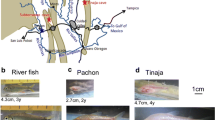Abstract
The nocturnal Mexican catfish Rhamdia laticauda (Pimelodidae, Teleostei) is the surface sister species of a number of cave species. Comparison between two of them, R. zongolicensis and R. reddelli, reveals an intermediate state of reduction of the biologically functionless eyes, melanin pigmentation and the negative phototactic behavior. The surface species is perfectly adapted to life in darkness. Therefore only few constructive adaptations are developed in the cave species. For survival under conditions of low food supply in the caves the barbels are elongated to improve the senses of taste and touch and more fat can be deposited in the cave fish tissue. Due to convergent evolution the two cave species are morphologically much alike and show only minor diagnostic meristic differences. From geological data it can be concluded that the two cave species started troglobitic evolution at the end of Pleistocene.
Similar content being viewed by others
References
Ali, M.A. & M. Anctil. 1976. Retinas of fishes. Springer-Verlag, Berlin. 284pp.
Anderβon, O. 1992. Vergleichende Untersuchung der Augenentwicklung der oberirdischen undderHöhlenformen der Gattung Rhamdia (Pimelodidae, Pisces). Diploma Thesis, University of Hamburg, Hamburg. 60 pp.
Culver, D. & H. Wilkens. 2000. Critical review of the relevant theories of theevolution of subterranean animals. pp. 389–407. In: H. Wilkens, D. Culver & W. Humphreys (ed.) Ecosystems of the World, Volume 30, Subterranean Ecosystems, Elsevier, Amsterdam.
Fack, H. & H. Wilkens. 1989.Eye reduction in hybrids and a naturally variable cave form of Astyanax fasciatus (Characidae, Pisces). Mém. Biospéol. 16: 157–161.
Greenfield, D.W., T.A. Greenfield & R.L. Woods. 1982. A newsubspecies of cave-dwelling pimelodid catfish, Rhamdia laticauda typhla from Belize, Central America. Brenesia (19/20): 563–576.
Junge, P. 1993. Egg size and larval development of epigean and cave forms ofRhamdia (Pimelodidae, Pisces). pp 165–173. In: H. Schröder, J. Bauer & M. Schartl (ed.) Trends in Ichthyology, Blackwell Scientific Publications, Oxford.
Langecker, T.G. & H. Wilkens. 1992.Comparative ultrastructural studies on the pineal organ of the Mexican catfish Rhamdia laticauda (Heckel 1858) and one of its cave-dwelling derivatives (Pimelodidae, Teleostei). Acta Zool. 73: 247–253.
Langecker, T.G.,H. Schmale & H. Wilkens. 1993. Transcription of the opsin gene in degenerate eyes of cave-dwelling Astyanax fasciatus (Teleostei, Characidae) and of its conspecific epigean ancestor during early ontogeny. Cell Tiss. Res. 273: 183–192.
Miller, R.R. 1984. Rhamdia reddelli, new species, the first blind pimelodid catfish from MiddleAmerica, with a key to the Mexican species. Trans. San Diego Soc. Nat. Hist. 20: 135–144.
Miller, R.R.1986. Origin and geography of the fishes of Central Mexico. pp. 487–517. In: C.H. Hocutt & E.O. Wiley (ed.) The Zoogeography of North American Freshwater Fishes, John Wiley & Sons, New York.
Mitchell, R.M.,W.H. Russell & W.R. Elliott. 1977. Mexican eyeless characin fishes, genus Astyanax: environment, distribution, and evolution. Sp. Publ. Mus. Tex. Tech Univ. (12): 1–89.
Mosier, D. 1984. Cave dwelling populationsof Rhamdia (Pimelodidae). Assoc. Mex. Cave Stud. Act. Newsl. 14: 40–44.
Myers, G.S. 1966.Derivation of the freshwater fish fauna of Central America. Copeia 1966: 766–773.
Pohlman, J. W.,L.A. Cifuentes & T.M. Iliffe. 2000. Food web dynamics and biogeochemistry of anchialine caves: a stable isotope approach. pp. 351–363. In: H. Wilkens, D. Culver & W. Humphreys (ed.) Ecosystems of the World, Volume 30, bterranean Ecosystems, Elsevier, Amsterdam.
Robertson, S. 1983a. Zongolica project.1983. Assoc. Mex. Cave Stud. Act. Newsl. 13: 36–41.
Robertson, S. 1983b. Cueva delTúnel, Veracruz. Assoc. Mex. Cave Stud. Act. Newsl. 13: 47–49.
Rosen, D.E. 1978.Vicariant patterns and historical explanation in biogeography. Syst. Zool. 27: 159–188.
Sbordoni, V.,R. Argano, V. Vomero & A. Zullini. 1977. Ricerche sulla fauna cavernicola del Chiapas (Messico) e delle regioni limitrofe: grotte esplorate nel 1973 e nel 1975. Criteri per una classificazione biospeleologica delle grotte. Quaderni Accad. Naz. Lincei (171, Part 3): 5–74.
Silfvergrip, A.M.C. 1996. A systematic revision of theneotropical catfish genus Rhamdia (Teleostei, Pimelodidae). Swedish Museum of Natural History, Stockholm. 156 pp.
Weber, A. 1995. The lateral line system of epigean and cave dwelling catfishes of the genus Rhamdia(Pimelodidae, Teleostei) in Mexico. Mém. Biospéol. 22: 215–225.
Weber, A. 1996.Cave dwelling catfish populations of the genus Rhamdia (Pimelodidae, Siluroidei, Teleostei) in Mexico. Mém. Biospéol. 23: 73–85.
Weber, A. & H. Wilkens. 1998. Rhamdia macuspanensis: a newspecies of troglobitic pimelodid catfish (Siluriformes; Pimelodidae) from a cave in Tabasco, Mexico. Copeia 1998: 998–1004.
Wilkens, H. 1982. Regressive evolution and phylogenetic age: the history of colonization offreshwaters of Yucatan by fish and crustacea. Assoc. Mex. Cave Stud. Bull. 8: 237–243.
Wilkens, H.1988. Evolution and genetics of epigean and cave Astyanax fasciatus (Characidae, Pisces). Support for the Neutral Mutation Theory. Evol. Biol. 23: 271–367.
Wilkens, H. 1993. A new species of Rhamdia (Pisces:Pimelodidae) from a cave in the Sierra de Zongolica (Veracruz, Mexico). Mitt. Hamb. Zool. Mus. Inst. 90: 375–378.
Wilkens, H. 1998. Genetics of cave fishes. pp. 1201–1213. In: C. Juberthie & V. Decu (ed.)Encyclopaedia Biospeologica, Tome II, Société de Biospéologie, Moulis.
Wilkens H.,P. Junge & T. G. Langecker. 1991. Speciation in troglobites: studies in the San Antonio Cave (Oaxaca, Mexico). Int. J. Speleol. 20: 1–13.
Wilkens, H. & M. Meyer. 1993. Eye formation andregression during early ontogeny in cave fish. pp. 185–192. In: H. Schröder, J. Bauer & M. Schartl (ed.) Trends in Ichthyology, Blackwell Scientific Publications, Oxford.
Yamamoto, Y. & W. R. Jeffery.2000. Central role for the lens in cave fish eye degeneration. Science 289: 631–633.
Author information
Authors and Affiliations
Rights and permissions
About this article
Cite this article
Wilkens, H. Convergent Adaptations to Cave Life in the Rhamdia Laticauda Catfish Group (Pimelodidae, Teleostei). Environmental Biology of Fishes 62, 251–261 (2001). https://doi.org/10.1023/A:1011897805681
Issue Date:
DOI: https://doi.org/10.1023/A:1011897805681




